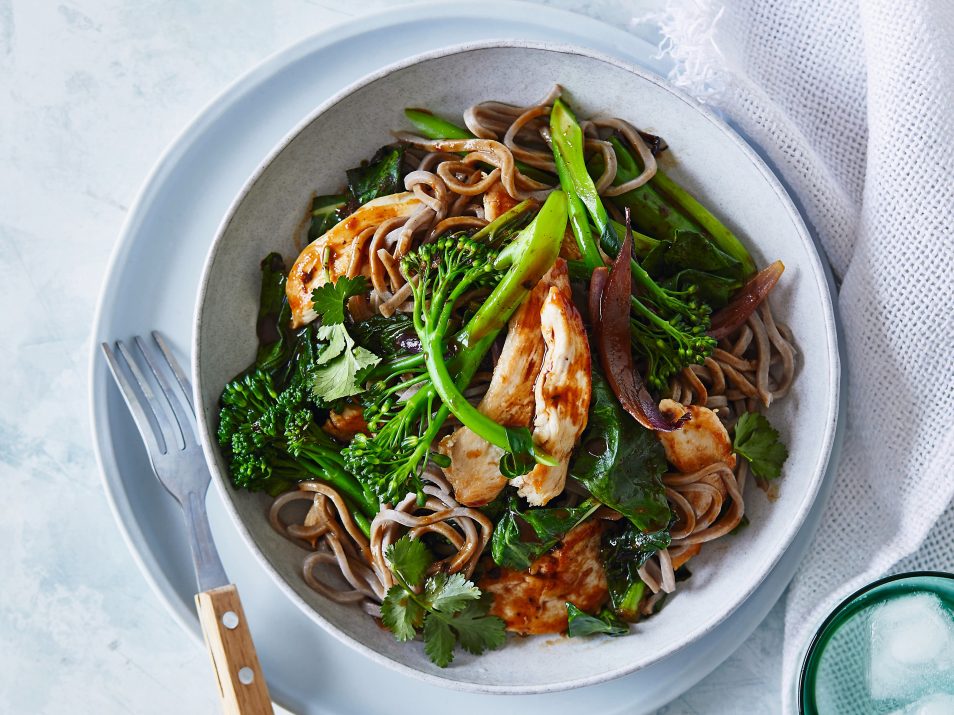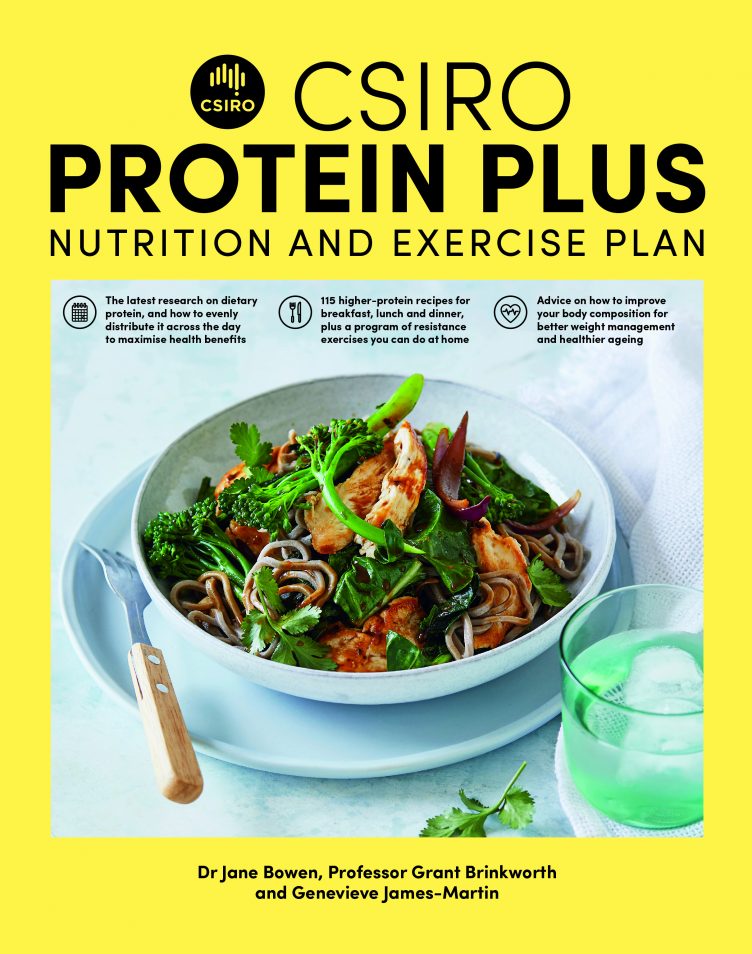
Chicken Soba Noodles – one of the many protein-rich recipes we have in our new Protein Plus Nutrition and Exercise Plan.
Buy the CSIRO Protein Plus Diet Book here.
What did your day of eating look like yesterday?
Did you have a piece of toast and a banana for breakfast while you were running out the door?
What about a salad wrap you ate while working through your lunch break?
How about dinner? Did you sit down to stir-fry, risotto or steak and salad?
These options are fairly typical for most Australians – but there is something askew. Can you guess what it is?
A lack of protein in each meal.
While most of us probably eat enough protein overall, we tend to eat our protein towards the end of the day, as you can see in the example given above. In fact – we’ve crunched the numbers – and the average Aussie adult has three times more protein at dinner time compared to breakfast.
Australians are also getting far too much protein from high energy, nutrient-poor discretionary foods such as fried chicken or the humble meat pie.
So to help pack your plate with nutrient-rich foods from the core food groups we have developed the new CSIRO Protein Plus Nutrition and Exercise Plan. It focusses on protein from whole foods and the importance of spreading protein intake evenly across the day. The book includes sample meal plans, recipes and a resistance exercise program that can be done from home.
This is a book for people looking for evidence-based, practical information which can be followed long term to maintain a healthy lifestyle…..and loads of inspirational, delicious recipes!
To help get you started we are sharing a couple of our favourite recipes from the book and step-by-step videos to show you how easy they are to make.
Pump up your breakfast protein with Corn Fritters with Feta
To request a transcript please contact us.
Serves: 4
Preparation: 20 minutes
Cooking: 10 minutes
Difficulty: Medium
Ingredients:
160 g reduced-fat feta, cut into 1 cm pieces (see Notes)
2 tablespoons red wine vinegar
1 cup flat-leaf parsley leaves
28 g pine nuts, toasted
olive oil spray, for cooking
8 large eggs
2 cobs sweetcorn, husks and silks
removed, kernels sliced off
80 g tasty cheese, grated
4 x 40 g slices multigrain bread, toasted
Method:
Combine the feta, vinegar, parsley and pine nuts in a bowl and season with freshly ground black pepper. Set aside.
Lightly spray a large non-stick frying pan with olive oil and place over medium heat. Liberally spray four 7 cm egg rings with oil and place in the pan. You’ll be cooking the fritters in two batches.
Crack an egg into each egg ring, then top with some of the corn kernels and cheese. Cook for 2 minutes, then flip and cook for a further 1 minute or until the whites have set, the yolks are still a little runny, and the cheese is melted and golden.
Carefully remove the fritters from the rings, place on a plate and cover to keep warm. Spray the egg rings again and repeat with the remaining eggs, corn and cheese to make eight fritters in total.
Divide the fritters among serving plates and spoon over the feta mixture.
Serve warm with toast.
NOTES
If you want to reduce the salt content of the feta, cut it into cubes and place in a bowl of water for 30 minutes to steep. Drain before use.
Pack your lunch with Chicken Soba Noodles
To request a transcript please contact us.
Serves: 4
Preparation: 15 minutes
Cooking: 10 minutes
Difficulty: Easy
Ingredients:
3 teaspoons sunflower oil
1 teaspoon sesame oil
400g lean chicken breast fillet,
thinly sliced crossways
1 red onion, cut into wedges
1 bunch Chinese broccoli, trimmed,
stems thinly sliced and leaves torn
2 tablespoons salt-reduced hoisin sauce
1 tablespoon salt-reduced soy sauce
2 teaspoons finely grated ginger
1 x 180 g packet shelf-fresh soba noodles
1 bunch broccolini, trimmed,
stalks halved lengthways, then
halved crossways
1/2 cup small coriander sprigs
Method:
Heat the sunflower and sesame oils in a large wok over high heat. Add the chicken and stir-fry for 3–4 minutes. Add the onion and cook for 1 minute.
Add the Chinese broccoli, hoisin, soy sauce, ginger and 2 tablespoons water. Stir-fry for 2 minutes or until the chicken is cooked and the vegetables are just tender.
Meanwhile, bring a large saucepan of water to the boil over high heat. Add the noodles and broccolini and cook for 1–2 minutes or until the noodles are heated through and separate easily, and the broccoli is just tender. Drain well, then divide among serving bowls.
Spoon the chicken mixture over the noodles, top with coriander and serve.
There are a heap more recipes available in our new book. Get your copy today!



23rd May 2019 at 12:58 pm
The book has portion sizes for 4+, how do I do portion size for 1
18th May 2019 at 9:24 pm
Does the book take into account vegetarians who cannot eat legumes due to IBS?
28th May 2019 at 3:11 pm
Hi Lib – yes! The book contains heaps of recipes which use soy and other plant-based proteins.
Kind regards,
Kashmi
CSIRO Social Media Team
17th May 2019 at 5:00 pm
Does this diet reduce Cholesterol
3rd June 2019 at 11:35 am
Hey John,
Thank you for your question about the CSIRO Protein Plus book. Healthy eating habits are one of the cornerstones to managing high cholesterol and triglyceride levels. This includes making a wide variety of fresh foods the main part of your diet, including fruit and vegetables, lean meat, poultry and fish, reduced fat dairy and plain unsalted nuts and legumes; and using healthy oils for cooking and healthy spreads such as avocado, nut butters or tahini. It is also important to avoid using butter, other dairy blends or cooking fats. While these recommendations are consistent with the CSIRO Protein Plus book, our book is not designed specifically for assisting in the management of high cholesterol and triglyceride levels. We recommend that you talk with your doctor about your health, including the need for any cholesterol-lowering medicines. Ask your doctor for a referral to an accredited practising dietitian to work out a dietary plan that is tailored to your needs. Finally, being active most days of the week is also important.
Kind regards,
Kashmi
CSIRO Social Media Team
26th April 2019 at 6:09 pm
Does the book include vegetarian options?